The magnetic field in solar active regions or in quiescent prominences
carries large electrical currents which store huge amounts of energy.
When this storage stresses the field too much, the configuration is
destabilized and erupts, suddenly transforming magnetic energy into
kinetic energy of coronal mass ejections, eruptive prominences and
flares. These most violent energy releases in the solar system also
perturb the terrestrial environment, which has become known as the space
weather. The strongest effects occur if plasma clouds are ejected with
high velocities of about 1000 km/s and above. Then the X-ray emissions
are hardest and most intense, relativistic particles fill interplanetary
space, and the electric currents induced upon impact at the terrestrial
magnetosphere and ionosphere are strongest. Understanding the trigger and
drive mechanisms of solar eruptions is a prerequisite in the quest to
achieve forecasting capability of space weather events and it is also of
general astrophysical interest, since similar eruptions occur on active
stars and possibly at galactic scales as well. However, several models
compete in explaining the triggering, and none of them has so far been
able to establish the conditions that lead to fast ejections.
Scientists at the AIP have recently discovered that a plasma instability
which is known and easily suppressed in the tokamak device used in fusion
research may trigger and drive solar eruptions. The instability causes
expansion of current rings that find their equilibrium in an externally
produced magnetic field and occurs if the field decreases sufficiently
rapidly with increasing distance from the ring. The current ring is of
toroidal shape in the tokamak, hence the name torus instability. Solar
coronal magnetic loops and prominence arches represent partial tori,
whose missing part may be thought of as being submerged below the
photosphere. While the shape of the external field is easily controlled
in the tokamak to ensure stability, the Sun may be unable to provide an
external field of the required shape, especially if the highly
concentrated field of active regions and in prominence environments is
strongly twisted or sheared as a result of the energy storage.
The instability not only represents a further model for the triggering of
the eruptions, it also has very interesting properties regarding the
acceleration and final velocity of the resulting ejecta. A strong
concentration of the acceleration low in the corona and high resulting
speed are predicted if the external field decreases steeply with height
above the original current ring – just as mass ejections from active
regions typically show. Gradual acceleration in a wide height range and
lower resulting speeds are predicted for prominence eruptions in the more
diffuse field outside of active regions, again as is typically observed.
A unifying mechanism for the apparently disparate classes of fast and
slow mass ejections has thus been found.
|
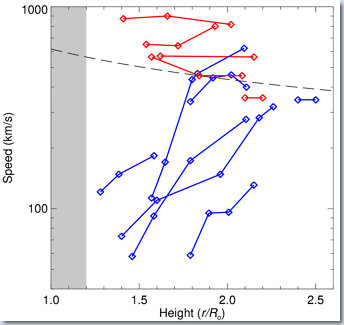
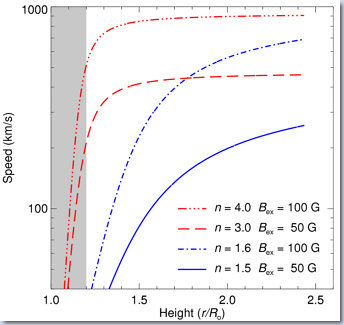
Figure 2:
Original observation of two apparently separate classes of coronal mass
ejections (data from MacQueen and Fisher 1983): fast flare-associated
ejections from active regions (red lines) acquire speeds of order
1000 km/s already very low in the corona (behind the occulting disk
indicated in grey) and then propagate with nearly constant speed, while
slow ejections (blue lines) are accelerated only gradually to reach the
gravitational escape speed (dashed line). The torus instability yields
similar velocity profiles, plotted here for a range of characteristic
decay indices n of the external field B, where n = 3 to 4 is
characteristic of active regions and n ≈ 3/2 is characteristic of
the quiet Sun.
|
|
|
|
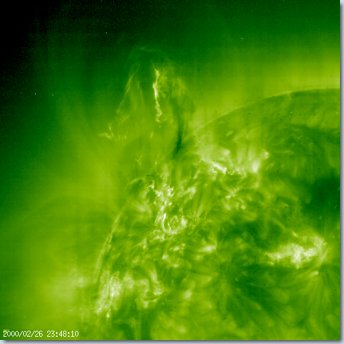
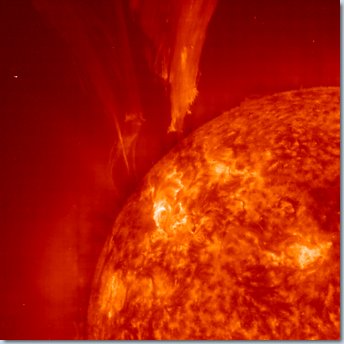
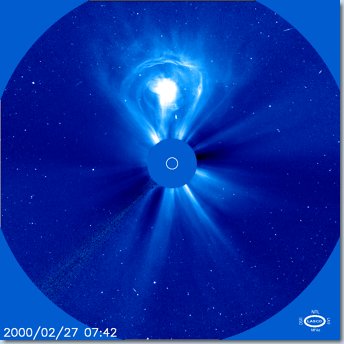
Figure 1:
Erupting prominence that evolved into a coronal mass ejection observed
by instruments on the SOHO satellite on 27 Feb 2000. The Sun is occulted
by a disk in the image of the mass ejection, with its size indicated by
the white circle.
|
Moreover, a direct link between the properties of the coronal magnetic
field and the velocity of mass ejections has been established for the
first time. The coronal field cannot be measured directly with sufficient
accuracy, but a combination of photospheric measurements, such as those
planned with AIP instrumentation on the new telescope GREGOR on Tenerife,
with numerical extrapolation of the field into the corona will permit
further investigations of the link. The authors expect that this research
will open a path to predicting the occurrence and the velocity of coronal
mass ejections successfully.
Bernhard Kliem, Tibor Török, Gottfried Mann
Contact
Dr. Bernhard Kliem
Astrophysikalisches Institut Potsdam
An der Sternwarte 16
D-14482 Potsdam
(0331) 7499 527

Publication
Bernhard Kliem & Tibor Török:
Torus Instability.
Physical Review Letters 96, 255002 (2006);
arXiv: physics/0605217
[Radio solar physics group]
[AIP home page]
|


 last change 2006 August 14, R. Arlt
last change 2006 August 14, R. Arlt


